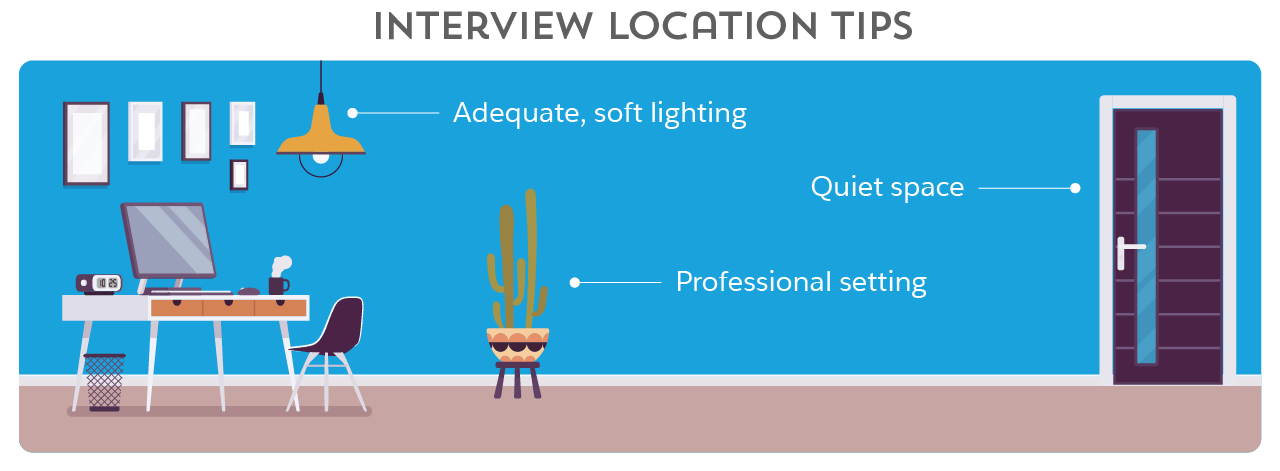7 Tips to Ace Your Virtual Interview

At Salesforce it’s rare to attend a meeting without at least a few participants attending virtually. Ask nearly any Salesforce employee about the feeling of meeting someone in-person for the first time after countless meetings on the screen. Chances are they will tell you it feels like seeing a best friend after a long period of time. This feeling is proof that you can get to know someone in your neighboring city or across the world through a screen.
With the advancement of video conferencing technology, the opportunity to connect with anyone, anywhere, at anytime becomes a reality. More and more we see companies incorporating virtual meetings into their day-to-day and it’s becoming commonplace in the interview process. In the Fourth Industrial Revolution being a compelling communicator – including online – is a critical skill to help advance your career. We’ve compiled tips to help you stand out on the screen.
1. Prepare the Basics
Some of these may seem obvious, but they are so important, we have to mention them. Feeling a little nervous before an interview is natural. Consider this your checklist to relieve those last minute jitters.
- Test Your Set Up: Most meetings will be held using Google Hangouts, but your recruiting partner will provide guidance unique to your interview. Ask a friend or family member to help you ensure your equipment is working and that you’re familiar with the controls. Consider wearing a headset or noise canceling headphones so that your audio is heard clearly.
- Power Up: Make sure your computer has full power and/or is plugged in.
- Be Visible: Keep your camera on at all times, unless it causes a lag. If this occurs, you could connect directly to your router or try sitting next to your device. Another option is to discuss turning off the camera to improve the connection with your interviewer. Be mindful that some individuals, particularly those with hearing impairments, may still prefer to keep the camera on so they can speech read. Closed captioning can also be enabled using these directions.
- Join on Time: Arrive early, just as you would for an on-site interview.
- Be Present: Give the interviewer 100% of your attention. Turn off your other technology to avoid multi-tasking like checking email, phone, etc.
- Select Your Location Intentionally: Represent your personal brand by choosing a quiet space when possible that allows you to focus, has soft lighting, and minimizes distractions. Your “home office” may be a bedroom, a common space, or maybe you’re lucky enough to have a proper office. In any case, interviewers aren’t concerned with how upscale your setting is. Simply control the elements of your environment that you’re able to.

Remember: sometimes despite our best attempts, things can go awry. If that happens to you, take a deep breath and do your best to communicate with the interviewer. Unforeseen technical challenges or interruptions can be opportunities to showcase your problem-solving skills, adaptability, and sense of humor.
2. Master The Digital Handshake
In a virtual meeting, you can recreate the “handshake” experience with a strong introduction and first impression. Greet the interviewer enthusiastically. Make eye contact by looking directly into the camera, rather than looking at the screen. Show your enthusiasm through your body language — lean in and be mindful not to cross your arms. And take a moment to connect, as you would if you were walking the hallways on your way to a meeting room.
3. Treat It Like Any Other Interview
The following best practices apply to both on-site and virtual interviews.
- Study the Job Description: Make an inventory of your skills and experience that align with each job requirement, and be ready to showcase them. It’s okay if some skills are areas of growth for you. In these instances showcase your ability and agility to grow and learn new things.
- Research the Interviewer(s): Once interview attendees are confirmed, look them up on professional networking sites like LinkedIn to get familiar with their background. Identify questions based on their experience and interests.
- Practice and Prepare: If your interview process includes a panel presentation, be sure to practice! Conducting a dry run with family, friends, or peers can perfect your talk track.
- Dress the Part: Salesforce tends to be more casual, but this doesn’t mean there isn’t a time or a place to step it up a bit. Bring your authentic self to the interview. We want you to get to know you and what makes you unique.
4. Show Your Passion
What motivates you? Why Salesforce? Interviews are your chance to make a lasting first impression. Be ready to show your excitement for the role – and most importantly, be you! Authenticity helps to build trust (our number one value!).
- Don’t Read a Script: When you’re behind a computer screen, it can be tempting to read notes to help you nail the pitch you practiced. But this will impact your delivery and ability to read and respond to facial expressions. Be confident! No one knows your background better than you do.
- Share Your Interests: Be candid about your likes and dislikes, where you think you can add value, and your long-term goals. When you’re transparent about who you are, the Hiring Team can ensure a great fit.
- Be Ready to Share “Why Salesforce”: What attracted you to this role? This will help our hiring team understand your values and how you’re hoping to add value to our company.
- Speak Candidly: “I wasn’t as responsive during the interview process as I would have preferred,” internal candidate Melanie Quandt reflects. “My availability was limited as I juggled being a new mom to two beautiful children. I was candid about it, and appreciated the support from the recruiter. I’m even happier in this role because I know our company practices inclusivity and promotes work/life integration.”

5. Embrace Feedback:
Remember, feedback is a gift. Our commitment to innovation means we know we can always do things a little better. Demonstrate your learner mindset by asking for, and incorporating, feedback. Be prepared to give feedback too — it shows your interest and observations.
6. Ask Questions
Even if you’re far along in your interview process, there are still things to be discovered! Did someone mention a topic you don’t know much about? Curious to learn more? Speak up and ask! Not only will you gain more knowledge about the team you may potentially join, but you’ll also show your genuine interest in the role and willingness to learn. It may also help to prep a few questions before each stage of the process.
7. Send Thank You Notes
After your interview concludes, take a moment to send a simple email thanking the interviewers for their time, and following up on any additional questions. It’s as easy as 3-2-1:
- Send the thank you note within three days of your interview.
- It can be short and sweet! At least two lines of text is recommended.
- Send one note to everyone you interacted with.

Our goal is to help you shine throughout your interview process. For more insider tips, watch our Virtual Panel: Discover the Most In-Demand Sales Skills.
We also recommend exploring these additional resources on our Careers Site:
- Navigate the Salesforce Hiring Process Trailhead Module
- 5 Things You Really Need to Know For Your Technical Interview From a Lead Engineer
- Candidate Resources and Interview Tips
Ready to transform your everyday? Indicate your interest to the Salesforce Recruiting team.

